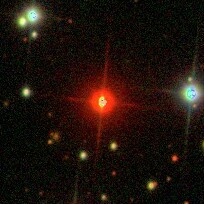Wolf 1069
| Observation data Epoch J2000 Equinox J2000 | |
|---|---|
| Constellation | Cygnus[1] |
| Right ascension | 20h 26m 05.30213s[2] |
| Declination | +58° 34′ 22.6804″[2] |
| Apparent magnitude (V) | 14.2[3] |
| Characteristics | |
| Evolutionary stage | Main sequence |
| Spectral type | M5.0V[4] |
| Apparent magnitude (G) | 12.352±0.003[2] |
| Apparent magnitude (J) | 9.029±0.039[5] |
| Apparent magnitude (H) | 8.483±0.073[5] |
| Apparent magnitude (K) | 8.095±0.021[5] |
| Astrometry | |
| Radial velocity (Rv) | −60.26±0.54[2] km/s |
| Proper motion (μ) | RA: 261.038 mas/yr[2] Dec.: 542.906 mas/yr[2] |
| Parallax (π) | 104.4415 ± 0.0261 mas[2] |
| Distance | 31.229 ± 0.008 ly (9.575 ± 0.002 pc) |
| Absolute magnitude (MV) | 14.3[3] |
| Details[4] | |
| Mass | 0.167±0.011 M☉ |
| Radius | 0.1813±0.0063 R☉ |
| Luminosity (bolometric) | 0.002944±0.000028 L☉ |
| Habitable zone inner limit | 0.056 AU |
| Habitable zone outer limit | 0.111 AU |
| Surface gravity (log g) | 4.93±0.06 cgs |
| Temperature | 3158±54 K |
| Metallicity [Fe/H] | 0.07±0.19 dex |
| Rotation | 150–170 days |
| Rotational velocity (v sin i) | <2 km/s |
| Other designations | |
| Database references | |
| SIMBAD | data |
Wolf 1069 is a red dwarf star located 31.2 light-years (9.6 parsecs) away from the Solar System in the constellation of Cygnus. The star has 17% the mass and 18% the radius of the Sun, a temperature of 3,158 K (2,885 °C; 5,225 °F), and a slow rotation period of 150–170 days. It hosts one known exoplanet called Wolf 1069 b which could possibly sustain life.[4]
Planetary system
[edit]A planetary companion to Wolf 1069 was discovered in 2023 via radial velocity. It has a minimum mass close to that of Earth and orbits within the habitable zone of its star, with an orbital period of 15 days. This planet does not transit its host star. Observations have ruled out any additional planets greater than one Earth mass with orbital periods of less than 10 days.[4]
As of its discovery, Wolf 1069 b is the sixth-closest known Earth-mass planet within the conservatively-defined habitable zone, after Proxima Centauri b, GJ 1061 d, Teegarden's Star c, and GJ 1002 b & c.[4]
| Companion (in order from star) |
Mass | Semimajor axis (AU) |
Orbital period (days) |
Eccentricity | Inclination | Radius |
|---|---|---|---|---|---|---|
| b | ≥1.26±0.21 M🜨 | 0.0672±0.0014 | 15.564±0.015 | — | — | ~1.08[note 1] R🜨 |
Notes
[edit]- ^ The radius of this planet has not been measured; this value is an estimate.
References
[edit]- ^ "Finding the constellation which contains given sky coordinates". djm.cc. 2 August 2008.
- ^ a b c d e f Vallenari, A.; et al. (Gaia collaboration) (2023). "Gaia Data Release 3. Summary of the content and survey properties". Astronomy and Astrophysics. 674: A1. arXiv:2208.00211. Bibcode:2023A&A...674A...1G. doi:10.1051/0004-6361/202243940. S2CID 244398875. Gaia DR3 record for this source at VizieR.
- ^ a b Houdebine, Éric R.; Mullan, D. J.; Doyle, J. G.; de la Vieuville, Geoffroy; Butler, C. J.; Paletou, F. (2019). "The Mass-Activity Relationships in M and K Dwarfs. I. Stellar Parameters of Our Sample of M and K Dwarfs". The Astronomical Journal. 158 (2): 56. arXiv:1905.07921. Bibcode:2019AJ....158...56H. doi:10.3847/1538-3881/ab23fe. S2CID 159041104.
- ^ a b c d e f Kossakowski, D.; Kürster, M.; et al. (January 2023). "The CARMENES search for exoplanets around M dwarfs, Wolf 1069 b: Earth-mass planet in the habitable zone of a nearby, very low-mass star". Astronomy & Astrophysics. 670: A84. arXiv:2301.02477. Bibcode:2023A&A...670A..84K. doi:10.1051/0004-6361/202245322.
- ^ a b c d "Wolf 1069". SIMBAD. Centre de données astronomiques de Strasbourg. Retrieved 9 January 2023.

